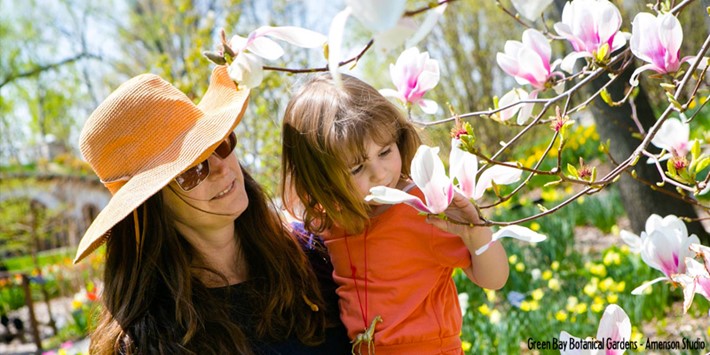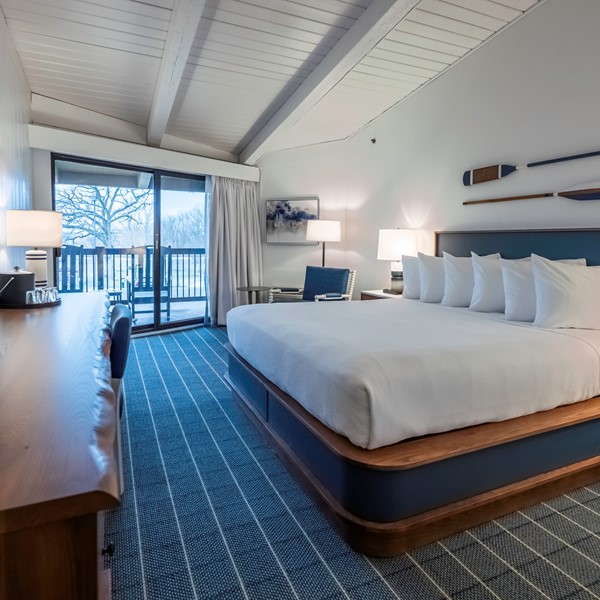
14 Wisconsin Flower Gardens for Beautiful Blooms
By Mary Lou Santovec
Special to TravelWisconsin.com
Lakes and rivers. Hills and valleys. Wildlife and forests. Wisconsin has an abundance of natural resources. But the list of the state’s environmental assets should also include its public gardens.
The best known, of course, are Olbrich Botanical Gardens in Madison and Boerner Botanical Gardens in Milwaukee. But there are hundreds more tucked away in small town and big city parks, nature centers, even around hospitals or on college campuses.
Not surprisingly, the oldest public gardens are in Milwaukee. The Victorians picnicked while visiting their deceased loved ones in Forest Home Cemetery, a garden cemetery established in 1850, which now contains several formal gardens. The great landscape architect Frederick Law Olmsted, who created New York’s Central Park, left his imprint on several of the green spaces in Wisconsin's largest city, including Lake Park in 1889, Riverside Park and Washington Park. These parks were considered “gardens for the poor,” a means of escape for the urban dweller.
A little further to the north, the far-sighted Walter J. Kohler, Sr., president of the Kohler Company, traveled to England in 1913 to view the work of Sir Ebenezer Howard, the godfather of the garden community movement. The movement reserved the town center for residences and parks and the outskirts for transportation and industry. The village of Kohler ultimately became the first fully developed garden community in the United States and in 2004, it received botanical garden status.
With such an extensive history of public gardens in the state, there are many wonderful places to visit. But the following 14 are worth a special trip. And while the colorful blooms are seasonal, most of the gardens are open year-round for those who enjoy Mother Nature’s yearly changes.
Olbrich Botanical Gardens – Madison
Specialties: The Bolz Conservatory features more than 650 species of tropical plants from Florida and Central and South America. The Thai garden, with its gold leaf-accented teak pavilion, is the only authentic one in the continental United States.
Why it makes the list: Olbrich received the annual Award for Garden Excellence from the American Association of Botanic Gardens and Arboreta, the plant world’s equivalent of winning an Oscar.
Interesting trivia: The Sunken Garden’s pool is dyed with beet juice to give the impression of depth.
Date open: Year-round.
Peak time: Spring bulbs peak in May, while the annuals/perennials peak in July/August.
Boerner Botanical Gardens – Milwaukee
Specialties: Varieties of “antique” daylilies, collections of tree peonies, shrub roses, and bearded iris and seven varieties of peonies hybridized in the 1800s are found here.
Why it makes the list: The Rose Garden is one of about two dozen rose test sites across the country and an official display garden for the All-America Rose Selections. Trial and test gardens for annuals and vegetables also are on display.
Interesting trivia: The gardens are named for Milwaukee landscape architect Alfred Boerner. But some of the 3,000 rose bushes in the Rose Garden actually came from Alfred’s brother, Eugene, nicknamed “Papa Floribunda” for his work in saving cutting stock from the Nazis during World War II.
Date open: Year-round
Peak time: May for spring flowers, June for the roses and perennials, and July for annuals.
Green Bay Botanical Gardens – Green Bay
Specialties: Opened in 1996, this relatively newer garden already contains collections of ornamental onions, magnolias, grape hyacinths and several varieties of Purple Passion tulips.
Why it makes the list: Remarkable plants accent impressive hardscapes such as the Schierl Wellhouse with its chocolate kiss-like roof, the copper-roofed Stumpf Belvedere, and the Meredith B. Rose Cottage.
Interesting trivia: As a daylily repository, gardeners can obtain pollen from any of the more than 180 daylilies to hybridize their own flowers.
Date open: Year-round.
Peak time: Spring flowers and magnolias peak in mid-May, daylilies peak in late July, and annuals and perennials peak in July/August.
Specialties: One of the few fern and moss gardens in the United States is here. Collections of narcissus, hostas, daylilies, and alliums are joined by 80 varieties of nicotiana (flowering tobacco), 115 of celosia and 40-plus types of morning glory plants.
Why it makes the list: The garden was named a National Display Garden for the American Hosta Society, and the Japanese garden is likely the largest one in the state.
Interesting trivia: The Japanese Garden’s bright red bridge was made from recycled curved light poles reclaimed from the city’s wastewater treatment plant. The footbridge zigzags to ward away evil spirits that the Japanese believe can only travel in a straight line.
Date open: Year-round.
Peak time: Spring bulbs peak in May, alliums peak in late May, roses peak in mid-June, and annuals/perennials peak in June/July.
The Paine Art Center and Gardens – Oshkosh
Specialties: The 18th Century reproduction Herb Garden contains more than 60 species. A tulip tree from George Washington’s Mount Vernon estate is found in the Secret Garden. A monochromatic or “moon” garden features plants with blooms or foliage in shades of white, silver and gray.
Why it makes the list: The 20 outdoor gardens or “galleries of horticulture” augment the revolving art exhibitions inside the museum.
Interesting trivia: This English country “estate” features the only public walled garden in Wisconsin.
Date open: The mansion is open year-round, but the gardens are open May through October.
Peak time: Spring bulbs peak in May; perennials in June; and the annuals and wildflowers in July.
Allen Centennial Gardens – University of Wisconsin-Madison
Specialties: Exotic shrubs, dwarf conifers, and native plants all have individual gardens here.
Why it makes the list: The 22 gardens are an outdoor classroom and laboratory for University of Wisconsin horticulture and landscape architecture students, so the newest varieties are always on display.
Interesting trivia: A version of the Seat Bridge found in the Governor’s Palace garden at Colonial Williamsburg goes over the pond.
Date open: Year-round
Peak time: Spring bulbs peak in May, and annuals/perennials peak in July/August
Botany Garden and Greenhouses – University of Wisconsin-Madison
Specialties: Plants from around the world fill this beautiful world-class research garden and the greenhouses that support it.
Why it makes the list: The garden utilizes the new Angiosperm Phylogeny Group system of molecular classification. The greenhouse features three specimens of the rare Titan arum, fondly known as the corpse plant for its rotten meat smell when it blooms.
Interesting trivia: Ferns are the lowest plant forms on the evolutionary scale, while daisies are the highest.
Date open: The garden is open year-round; greenhouses are open when class is in session.
Peak time: July/August
The Gardens of Kohler at the American Club – Kohler
Specialties: The Arts/Industry Walk sculpture garden and the floral artistry of seven creative gardens at The American Club.
Why it makes the list: The village features a variety of garden styles: formal, informal, container, prairie, sculpture, arboretum and nature walk.
Interesting trivia: In 2004 The American Public Garden Association (APGA) awarded the Village of Kohler membership as a registered botanical garden.
Date open: Year-round
Peak time: The gardens have various peak times. There’s generally something to see from early May to early October.
The Garden Door – Sturgeon Bay
Specialties: Trials of Echinacea (coneflowers) are being conducted to determine their hardiness in Wisconsin’s climate.
Why it makes the list: A variety of garden styles are represented here, including a rose garden, annual and perennial beds, a rock garden, a butterfly garden, a tunnel and sound garden, as well as several water features and unusual garden art.
Interesting trivia: It’s a demonstration garden for the Door County Master Gardeners.
Date open: The garden is part of the Peninsular Agriculture
Research Station. Access is available whenever the station is open.
Peak time: July/August
Gardens of the Fox Cities – Appleton
Specialties: Two separate types of rose gardens, formal and native, are here.
Why it makes the list: Various styles of gardens are on display including a fragrance garden, a dry stream bed, a four-season garden, a Wisconsin oak savanna, a family garden, a memorial garden, a children’s garden and an interesting water feature.
Interesting trivia: The Prairie-style Henry and Mary Scheig Learning Center was designed by Charles Montooth, a senior architect at Taliesin and a protégé of Frank Lloyd Wright.
Date open: Year-round
Peak time: Spring bulbs peak in May, annuals/perennials in July/August.
Warren J Taylor Sunken Flower Garden – Kenosha
Specialties: Fifty varieties of annuals, laid out in rows, contrast with manicured grass paths in this sunken garden.
Why it makes the list: One of the state’s few formal gardens devoted solely to annuals.
Interesting trivia: The gardens, containing 31 flowerbeds, were named for a former Kenosha park director/city planner.
Date open: The gardens are located in Lincoln Park and are open when the park is open.
Peak time: July
Villa Terrace Renaissance Garden – Milwaukee
Specialties: Brides who were married at Villa Terrace donated dwarf crabapple trees for the Bride’s Orchard. Look for culinary and medicinal herbs, potted citrus trees, roses and, in the spring, some 30,000 narcissus.
Why it makes the list: This formal Italian Renaissance garden containing Wisconsin-hardy 16th century Italian plantings is the only one of its kind in the state.
Interesting trivia: The Neptune Gate, with its Greek and Roman images, is one of the largest pieces of ironwork crafted in the past century.
Date open: The museum is open year-round. The summer opening for the garden is around June 1, but the garden can be seen from Lincoln Memorial Drive.
Peak time: Spring bulbs and crabapple trees peak in May, remainder peaks in June/July
Riverside International Friendship Gardens – La Crosse
Specialties: Plantings either native to, or inspired by, sister cities abroad. Look for two “Image D’Epinal” climbing roses in the French garden, flowering plum and ginkgo trees in the Chinese garden, ornamental hops in the German garden, and the Russian garden’s domed pavilion called a besedka.
Why it makes the list: The gardens replicate ones found in La Crosse’s sister cities in China, France, Germany, Russia, Ireland and Norway.
Interesting trivia: Paths through the gardens are made from the same material to convey that we’re all part of one world.
Date open: Because the gardens are part of Riverside Park, the gardens are open whenever the park is open.
Peak time: July
Specialties: Cold weather and sandy soil are no barrier to growing 1,000 perennial varieties.
Why it makes the list: Several large display gardens, including full shade, partial shade, and full sun as well as a border with multiple gardens grow a variety of cold-tolerant plants.
Interesting trivia: Technically located in Zone 3, the greenhouse has successfully grown plants recommended for Zone 5, a much warmer climate.
Date open: The greenhouse opens the last weekend in April for its bare root sale and the first weekend in May for its annual open house.
Peak time: July/August
Browse five more gardens heavily influenced by heritage at Wisconsin historical sites.










